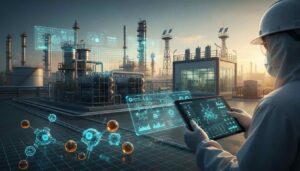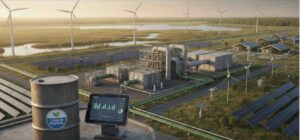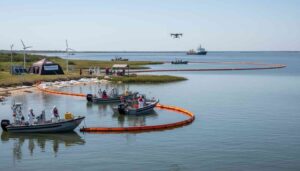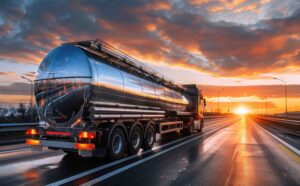Subsea production systems are critical components in the extraction of hydrocarbons from offshore reservoirs, particularly in deepwater and ultra-deepwater environments. These systems are located on the seabed and involve the extraction, processing, and transportation of oil and gas to the surface or directly to shore. Here’s an in-depth exploration of subsea production systems:
Overview of Subsea Production Systems
1. Components of Subsea Production Systems
- Subsea Trees (Christmas Trees): These are the key components of a subsea production system, installed on the wellhead to control the flow of hydrocarbons. They can be either vertical or horizontal in design and include valves, sensors, and other instruments to manage and monitor well production.
- Subsea Manifolds: These structures collect hydrocarbons from multiple wells and direct the flow to a central processing facility, either on a platform or a floating production storage and offloading unit (FPSO). Manifolds also distribute injection fluids like water, gas, or chemicals to enhance reservoir recovery.
- Subsea Control Systems: These systems manage and monitor the operation of subsea trees, manifolds, and other equipment. Control systems include hydraulic, electrical, and fiber optic lines that transmit data and commands between the surface and the seabed.
- Subsea Umbilicals: Umbilicals are composite cables that supply power, control signals, and chemicals to subsea systems. They connect the subsea equipment to the surface facility and are critical for the operation and maintenance of the entire system.
- Flowlines and Risers: Flowlines transport hydrocarbons from the wellheads to the manifolds or directly to the surface facilities. Risers are vertical pipelines that connect the subsea flowlines to the surface production platform or FPSO.
- Subsea Boosting Systems: These include subsea pumps and compressors that increase the pressure of the produced fluids, helping to overcome the challenges of deepwater production and long-distance transportation.
- Subsea Separation Systems: These systems separate oil, gas, and water on the seabed, allowing for more efficient transportation and processing. Subsea separation reduces the load on surface facilities and can extend the life of the reservoir.
2. Types of Subsea Production Systems
- Single Well Systems: These systems are used for isolated wells or where a single well is sufficient to exploit a reservoir. They typically consist of a subsea tree, umbilical, and flowline.
- Cluster Well Systems: In areas with multiple wells close to each other, a cluster well system is used. The wells are connected to a central manifold, reducing the number of flowlines required to transport the hydrocarbons to the surface.
- Template Systems: Templates are large structures installed on the seabed, accommodating multiple wells and manifolds. They are often used in large fields to optimize the layout and reduce installation costs.
3. Installation and Commissioning
- Installation: The installation of subsea production systems is a complex process that involves the deployment of heavy equipment, often using specialized vessels and remotely operated vehicles (ROVs). Installation steps include laying pipelines, installing subsea trees, manifolds, and other components, and connecting them to the control systems and umbilicals.
- Commissioning: After installation, the system undergoes commissioning, where all components are tested to ensure they operate correctly under real-world conditions. This includes pressure testing, communication checks between the subsea and surface equipment, and verifying the flow of hydrocarbons.
4. Advantages of Subsea Production Systems
- Deepwater Capability: Subsea production systems enable the exploitation of deepwater and ultra-deepwater reservoirs that are inaccessible by traditional offshore platforms.
- Environmental Impact: Subsea systems minimize the surface footprint, reducing the environmental impact on marine and coastal ecosystems.
- Cost Efficiency: Although the initial cost of subsea systems can be high, they can be more cost-effective over the life of the field, especially in remote or deepwater locations where building and maintaining surface platforms is prohibitively expensive.
5. Challenges and Risks
- Technical Complexity: The design, installation, and maintenance of subsea production systems require advanced technology and expertise, making them highly complex operations.
- Maintenance and Repair: Accessing subsea equipment for maintenance or repairs is challenging and expensive, often requiring ROVs or specialized intervention tools.
- Flow Assurance: Managing the flow of hydrocarbons in subsea pipelines, especially over long distances and in cold environments, can be difficult. Issues like hydrate formation, wax deposition, and pipeline blockages must be managed to ensure continuous production.
- Corrosion and Material Degradation: The harsh subsea environment can lead to the degradation of materials used in subsea systems, necessitating the use of corrosion-resistant alloys and protective coatings.
6. Technological Innovations
- Subsea Processing: Advances in subsea processing technologies, including subsea separation, boosting, and reinjection, are transforming how hydrocarbons are managed on the seabed, reducing the reliance on surface facilities.
- Autonomous Systems: The development of autonomous subsea vehicles and drones for inspection, maintenance, and repair is reducing the need for human intervention, increasing safety, and lowering operational costs.
- Digital Twins: Digital twins of subsea systems, created using advanced modeling and simulation software, allow operators to monitor and optimize production in real-time, predicting issues before they occur.
7. Future Trends
- Deeper Water Exploration: As exploration moves into deeper waters, subsea production systems will continue to evolve, with a focus on enhancing reliability and reducing costs in extreme environments.
- Integration with Renewable Energy: There is growing interest in integrating subsea production systems with offshore renewable energy sources, such as wind or wave power, to provide the electricity needed for subsea operations.
- Enhanced Subsea Connectivity: Advances in subsea communication and control technologies, including high-bandwidth fiber optics and wireless systems, will improve the real-time monitoring and management of subsea fields.
8. Environmental and Regulatory Considerations
- Regulatory Compliance: Subsea production systems must adhere to stringent regulations governing safety, environmental protection, and operational integrity. This includes measures to prevent oil spills, minimize the impact on marine life, and ensure the safety of operations.
- Decommissioning: At the end of a field’s life, subsea systems must be safely decommissioned, with equipment either removed or left in place in an environmentally responsible manner. This involves detailed planning and compliance with international regulations.
Subsea production systems are vital to the future of offshore oil and gas production, particularly as the industry moves toward deeper and more challenging environments. Advances in technology, coupled with a focus on sustainability and operational efficiency, are driving the evolution of these systems, ensuring they remain a key component of global energy supply.
Read more on Sparkview Energy:
Natural Gas Compression: Equipment and Applications in the Midstream Sector
Managing Water Resources in Hydraulic Fracturing Operations
Evolving Employment Trends in the Oil and Gas Industry







